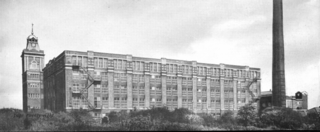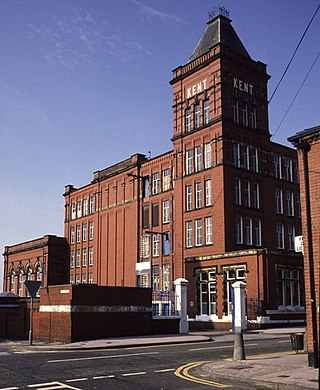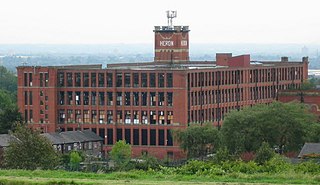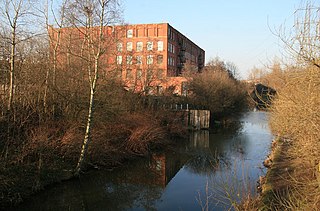
Trencherfield Mill is a cotton spinning mill standing next to the Leeds and Liverpool Canal in Wigan, Greater Manchester, England. It was built in 1907. It was taken over by the Lancashire Cotton Corporation in the 1930s and passed to Courtaulds in 1964. The mill was driven by a 2,500 hp triple-expansion four-cylinder engine built by J & E Wood of Bolton in 1907. The two halves of the engine were called Rina and Helen. They drove a 26-foot flywheel with 54 ropes at 68 rpm. The engine was stopped in 1968. The mill is now part of the Wigan Pier redevelopment area and is used for other purposes.
Magnet Mill, Chadderton is a cotton spinning mill in Chadderton, Oldham, Greater Manchester. It was built by the Magnet Mill Ltd. in 1902, but purchased by the Lancashire Cotton Corporation in 1935. It was later taken over by the Courtaulds Group. Ceasing textile production in December 1966, it was demolished soon after. A suburban residential estate now occupies this site. It was driven by a 2200 hp twin tandem compound engine by George Saxon & Co, Openshaw, 1903. It had a 27-foot flywheel with 35 ropes, operating at 64½ rpm.

Ace Mill is a cotton spinning mill in Chadderton in the Metropolitan Borough of Oldham, Greater Manchester. It was built as Gorse No. 2 Mill, in 1914 and cotton was first spun in 1919 by the Ace Mill Ltd, who renamed the mill. It was taken over by the Lancashire Cotton Corporation in the 1930s and passed to Courtaulds in 1964. Production ended in 1967.

Arkwright Mill, Rochdale is a cotton spinning mill in Rochdale, Greater Manchester. It was built in 1885 by the Arkwright Cotton Spinning Co. It was taken over by the Lancashire Cotton Corporation in the 1930s and passed to Courtaulds in 1964. It was located next to Dale Mill on Roch Street. The ring and doubling frames were made by Howard & Bullough, Accrington. The mill closed in 1980, was demolished in 2007 and the land redeveloped for housing.

Blackridings Mill, Oldham was a cotton waste mill lying off Block Lane in the Werneth area of Oldham, Greater Manchester. It was built before 1861 and ceased spinning between 1875 and 1880. It was then used for flock manufacture and processing cotton waste. It was taken over by the Lancashire Cotton Corporation in the 1930s and passed to Courtaulds in 1964. Production ended in 1973 and the building was demolished in 1975.

Mavis Mill was a cotton spinning mill in Coppull, Chorley, Lancashire

Fox Mill was a cotton spinning mill in Hollinwood, Oldham, Greater Manchester, England. It was taken over by the Lancashire Cotton Corporation in the 1930s and passed to Courtaulds in 1964.

Royton Ring Mill was a cotton mill in Royton, Greater Manchester, England. It was built in 1908 and extended in 1912. It was taken over by the Lancashire Cotton Corporation in 1935 and passed to Courtaulds in 1964. Production finished in 1966. It was extended again in 1969 and used for other purposes. It has now been demolished, the street has been renamed and houses have replaced it.

May Mill was a cotton spinning mill in Pemberton, Wigan, Greater Manchester, England. Historically in Lancashire, it was built in 1889. It was taken over by the Lancashire Cotton Corporation in the 1930s and passed to Courtaulds in 1962–63 to produce carpet fibre, which it continued to do until its closure on 17 October 1980.

Pilot Mill, Bury is a four-storey cotton spinning mill in Bury, Greater Manchester, England. It was built in 1905 for the Pilot Spinning Co. It was taken over by the Lancashire Cotton Corporation in 1939. The mill closed in 1962 and was later sold to Antler Luggage. The Mill is currently occupied by Baum Trading Ltd and Metzuyan Ltd they have opened a retail outlet with an on site cafe.

Kent Mill, Chadderton was a cotton spinning mill in Chadderton, Oldham, Greater Manchester. It was built in 1908 for the Kent Mill Co. It was taken over by the Lancashire Cotton Corporation in 1938 and passed to Courtaulds in 1964. Production finished in 1991 and it was demolished in 1994.

Manor Mill, Chadderton is an early twentieth century, five storey cotton spinning mill in Chadderton, Oldham, Greater Manchester. It was built in 1906. It was taken over by the Lancashire Cotton Corporation in the 1930s and passed to Courtaulds in 1964. Production finished in 1990.

Monton Mill was a cotton spinning mill in Eccles, Greater Manchester, England, built in 1906. It was taken over by the Lancashire Cotton Corporation in the 1930s and passed to Courtaulds in 1964. After production ended, it was demolished and replaced with housing; its name is preserved in the street name.

Heron Mill is a cotton spinning mill in Hollinwood, Oldham, Greater Manchester. It was designed by architect P. S. Stott and was constructed in 1905 by the Heron Mill Company Ltd next to Durban Mill. It was taken over by the Lancashire Cotton Corporation in the 1930s and passed to Courtaulds in 1964. Production ended in 1960, and it was used by Courtaulds for offices, warehousing, and some experimental fabric manufacture. Courtaulds occupation ended in 1994 with the Andrew Design Procurement further holding the site until 1998.

Textile Mill, Chadderton was a cotton spinning mill in Chadderton, Oldham, Greater Manchester, England. It was built in 1882 by Potts, Pickup & Dixon for the Textile Mill Co. Ltd, and closed in 1927. It was taken over by the Lancashire Cotton Corporation in the late 1940s and passed to Courtaulds in 1964 and used for cotton waste sorting. Half of the building was destroyed by fire on 11 July 1950, but the remaining section continued to be used for cotton waste sorting by W. H. Holt and Son until 1988.

Royd Mill, Oldham was a cotton spinning mill in Hollinwood, Oldham, Greater Manchester, England. It was built in 1907, and extended in 1912 and 1924. It was taken over by the Lancashire Cotton Corporation in the 1930s and passed to Courtaulds in 1964. Production finished in 1981. The mill was demolished in 2015 to make way for a "DifRent" housing scheme.

Malta Mill, Middleton is a former cotton spinning mill in the Mills Hill area of Chadderton, Greater Manchester. It lies alongside the Rochdale Canal. It was built in 1904 as a new mule mill, by F. W. Dixon The engine stopped in 1963. The building still stands.

Laurel Mill was a cotton spinning mill in the Mills Hill/Middleton Junction area of Chadderton, Oldham, Greater Manchester, England.

Junction Mill, Middleton Junction is a cotton spinning mill at Middleton junction, Chadderton in Greater Manchester alongside the Rochdale Canal.

Mars Mill was a former cotton spinning mill in Castleton, Rochdale, Greater Manchester, England. Castleton joined the Borough of Rochdale in 1899. Queensway, Castleton was a hub of cotton mills; Mars, Marland, and Castleton Mill were a group of three. It was taken over by the Lancashire Cotton Corporation in 1935 and passed to Courtaulds in 1964 and demolished in the 1990s; Marland survived until 2004.






















